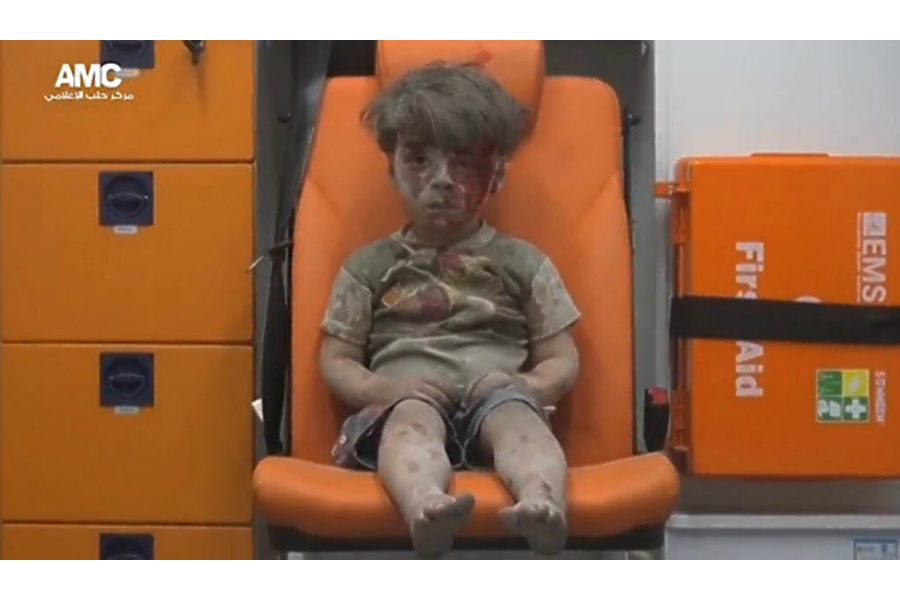Syrian boy in ambulance: can a photo bring about change?
Loading...
The image of the Syrian boy in the ambulance, pasted in dust, silent, and staring into the distance, evoked reactions of empathy, frustration, and anger on Thursday at the plight of the tens of thousands of children in Aleppo.
The video of 5-year-old Omran Daqneesh has been viewed more than 3 million times since it was published Wednesday, and elicited scores of comments on Twitter and Facebook. A rendering of Omran was even placed side-by-side with Alan Kurdi, the Syrian 3-year-old whose lifeless body washed ashore on a Turkish beach after he drowned in September.
Yet, in a war that has lasted for five years, with many critics feeling global powers have not done enough to intervene against civilian casualties, humanitarian organizations and media experts wonder if the image of Omran will lead to such actions as more aid to Syria, acceptance of more refugees, or more foreign intervention, or if it will become yet another case of "slacktivisim" – half-hearted activism that prompts images to go viral on social media, without resulting in further action.
Bernie Hogan, an internet sociologist at University of Oxford in England, tells The Christian Science Monitor that the image of Omran is significant because it has allowed those outside of Syria to empathize and see commonality with children and other civilians there.
“Few things bring us together like seeing the tragedy of a child or child’s face,” he says in a phone interview. “We’re programmed to evoke feelings of empathy for children.”
Predicting a reaction to that empathy is much more complicated, says Dr. Hogan. In response to the photograph of Alan, European countries agreed to accept more refugees. In response to the Ice Bucket Challenge, viral videos in which participants poured a bucket of ice water over their heads and challenged friends in their networks to do the same, nearly $80 million was raised for ALS research. In Syria, there isn't as clear a solution, says Hogan.
The video of Omran was published by the Aleppo Media Center, an anti-government activist group in Syria, after Omran was pulled from a building damaged in an airstrike in the rebel-held neighborhood of Qaterji, according to the Associated Press. In the video, an emergency worker carries Omran into the ambulance, where he stares into the distance, rubs his bloodstained face with his forearm, and inspects the blood smeared on his hand.
Omran suffered no brain damage, was treated at the underground hospital known by its code name, “M10,” and was released, Osama Abu al-Ezz, the doctor who saw Omran, told the Associated Press.
Hundreds of other children in Syria haven’t been so lucky. Since the start of war in 2011, the United Nations has documented nearly 600 cases of children being killed by airstrikes and bombings carried out by the Syrian government and its allies, according to ABC News. An estimated 100,000 children live in eastern Aleppo.
Of the millions of children who remain in Syria, more than 80 percent of them have been “harmed by war,” according to UNICEF.
“This is going to continue to happen until we have a real concerted effort to put protection of civilians first,” Jomana Qaddour, co-founder of Syria Relief and Development, tells the Monitor in a phone interview. She hopes the image of Omran further encourages the United States and its allies to stop the Syrian government from targeting civilians.
Twitter users, while echoing Ms. Qaddour's frustration, said it more bluntly on Thursday.
When the image of Alan, the Syrian toddler, elicited similar reactions, Europe was quick to act. Within a week of the publication of the photograph, Britain agreed to accept refugees after months of resisting. France and Germany also agreed to a new plan that included binding quotas for refugee distribution for most countries in the European Union.
"There can sometimes be this fatigue around wars and large-scale disaster. You hear this number 800,000 or 800, or whatever it is. It doesn’t feel real to people," Kate O'Sullivan, the communications manager of Save the Children in Greece, told the Monitor at the time. "But then you have this image of one child, who is the most innocent child you can imagine, and it is representative of everything."
Other images shared online haven’t brought about change as quickly. In July, the Revolutionary Forces of Syria Media Office, an organization of pro-opposition journalist-activists, photographed Syrian children holding images of printed Pokemon. They shared the pictures through #PokemonGo, the wildly popular mobile game.
“The media campaign aims to remind the world of that reality,” Simone McCarthy wrote for The Christian Science Monitor. “Playing on the fact that users have to go to the real-world location where the Pokemon are in order to catch them, the media campaign pictures children in Syria with digitally added Pokemon. One caption reads: “I am from #Syria come to save me!!!”
In some ways, the video of Omran is different, writes Anne Barnard for The New York Times:
Maybe it was his haircut, long and floppy up top; or his rumpled T-shirt showing the Nickelodeon cartoon character CatDog; or his tentative, confused movements in a widely circulated video – gestures familiar to anyone who has loved a child. Or the instant and inescapable question of whether a parent was left alive to give him a hug.
It may be the relatively familiar look of Omran’s distress that allows a broader public to relate to it.







